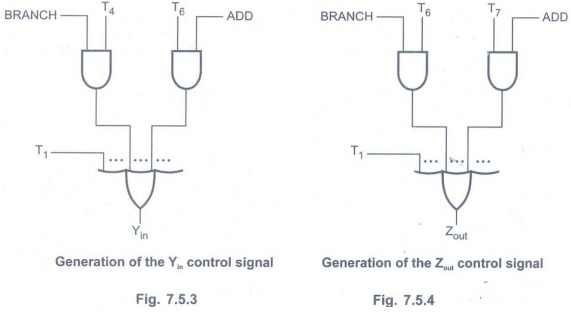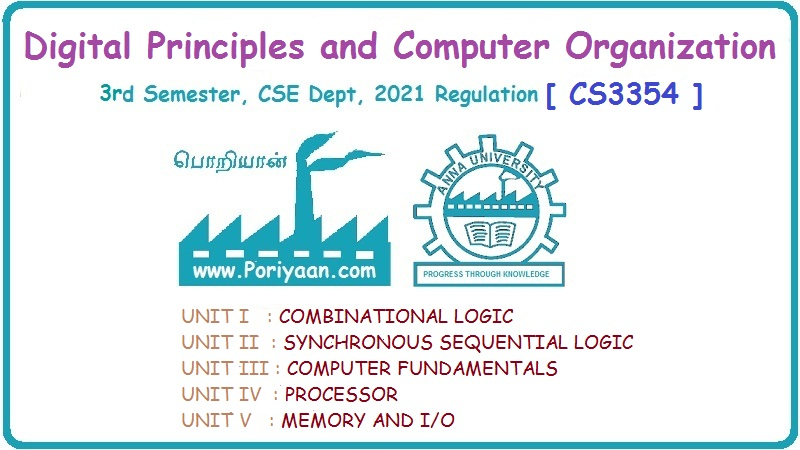Digital Principles and Computer Organization: Unit IV: Processor
Hardwired Control
Processor - Digital Principles and Computer Organization
In the hardwired control, the control units use fixed logic circuits to interpret instructions and generate control signals from them.
Hardwired Control
• In the hardwired control, the control
units use fixed logic circuits to interpret instructions and generate control
signals from them.
• The fixed logic circuits use contents
of the control step counter, contents of the instruction register, contents of
the condition code flag and the external input signals such as MFC and
interrupt requests to generate control signals.

• Fig. 7.5.1 shows the typical hardwired
control unit. Here, the fixed logic circuit block includes combinational
circuit (decoder and encoder) that generates the required control outputs,
depending on the state of all its inputs.
• By separating the decoding and encoding
functions, we can draw more detail block diagram for hardwired control unit as
shown in the Fig. 7.5.2.
• The instruction decoder decodes the
instruction loaded in the IR. If IR is an 8-bit
register then instruction decoder
generates 28, i.e. 256 lines; one for each instruction. According to
code in the IR, only one line amongst all output lines of decoder goes high
i.e., set to 1 and all other lines are set to 0.
• The step decoder provides a separate
signal line for each step, or time slot, in a control sequence. The encoder
gets in the input from instruction decoder, step decoder, external inputs and
condition codes. It uses all these inputs to generate the individual control
signals.
• After execution of each instruction end
signal is generated which resets control step counter and make it ready for
generation of control step for next instruction.

• Let us see how the encoder generates
signal for single bus processor organisation shown in Fig. 7.5.3 Yin.
The encoder circuit implements the following logic function to generate Yin
Yin= T1+ T6.
ADD + T4. BRANCH + ...
• The Yin signal is asserted
during time interval T1 for all instructions, during T for an ADD
instruction, during T4 for an unconditional BRANCH instruction and
soon.
• As another example, the logic function
to generate Zout signal can given by,
Zout = T2 + T7. ADD
+ T6
• The Zout signal is asserted
during time interval T2 of all instructions, during T, for an ADD
instruction, during T6 for an unconditional branch instruction and
so on.
• Fig. 7.5.3 and 7.5.4 shows the hardware
implementation of logic functions for Yin and Zout control
signals.

Example 7.5.1
Generate the logic circuit for the following function
End =T7.
ADD + T5 . BR + (T5. N T4.![]() ). BBN+...
). BBN+...
Solution :Fig.
7.5.5 shows the circuit that generates the End control signal from the logic
function.
End =T7. ADD + T5 . BR + (T5. N T4.![]() ). BBN+...
). BBN+...

Advantages of hardwired control unit
• Hardwired control unit is fast because
control signals are generated by combinational circuits.
• The delay in generation of control
signals depends upon the number of gates.
• It has greater chip area efficiency
since its uses less area on-chip.
Disadvantages of hardwired control unit
• More the control signals required by
CPU; more complex will be the design of control unit.
• Modifications in control signal are
very difficult. That means it requires rearranging of wires in the hardware
circuit.
• It is difficult to correct mistake in
original design or adding new feature in existing design of control unit.
Review Questions
1. Draw and explain typical hardwired
control unit.
2. With a diagram which shows the
separation decoding and encoding functions, explainhardwired control.
3. Show the generation Zin and end
control signal.
Digital Principles and Computer Organization: Unit IV: Processor : Tag: : Processor - Digital Principles and Computer Organization - Hardwired Control
Related Topics
Related Subjects
Digital Principles and Computer Organization
CS3351 3rd Semester CSE Dept | 2021 Regulation | 3rd Semester CSE Dept 2021 Regulation
